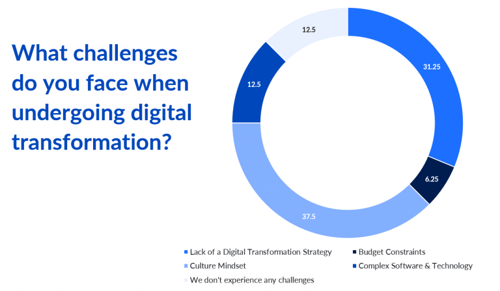Digital Transformation: Does It Have to be So Scary?
A few weeks ago, we hosted a webinar with Jason Bloomberg, President of Intellyx, and George Pang, Senior Solutions Consultant, at ValueBlue. They sat down and discussed what digital transformation looks like, the challenges transformation leaders face, and why transformation is essential to modern organizations.
Digitalization vs. Digitization: What’s the Difference
Essentially, digitization is taking analog information and converting it into a digital format. The example Bloomberg gave was taking an old VCR and transcribing it to a DVD. Another example would be taking your paper-based document and turning it into PDFs.
Digitalization, however, has a less clear-cut definition. At its core, digitalization is about transforming processes within a business. Digitization can be a piece of digitalization but takes transforming the data a step further to transform the organization. Here, Bloomberg explains that if a factory worker uses hands-on equipment like a lathe, and switches to a tool with a digital control panel, the entire process is transformed. In the end, you’re still making the same product, but the process to do so has been digitalized.
What is Digital Transformation?
Yet, how does digitalization relate to the bigger picture of digital transformation?
Much like digitalization, the definition of digital transformation can differ from organization to organization. However, the target remains to transform the business to be more customer-centric. And yes, while technology is what enables this shift, the transformation is ultimately about the people, not the technology. However, technology is what empowers to break down siloes across an organization so all teams can align around a customer’s needs.
Three Key Areas of Digital Transformation
During the webinar, we polled the audience to select their most significant barrier to digital transformation.
The highest number of respondents at 35% voted for culture/company mindset. Next, 29% voted for a lack of a digital transformation strategy. Last is 12% for budget constraints, complex software, and technology.

Budget
Like tools, the question shouldn’t be “What is our budget?”, but “What do we need to deliver the most value to our customers?” To this point, Bloomberg challenges the concept of budgets by saying, “Let’s move beyond projects and budgets as a way of thinking about how to organize the work in the organization and focus on customer value.” He is careful to state that he doesn’t think a company should spend whatever they want and throw out the entire concept of a budget, but rather if you find a tool that would make a customer happy, get it. It’s about shifting your mindset from this is what it costs, to this is what adds value.
Tools
Bloomberg observed the audience is correct in thinking tooling is a small part of the problem. The question here shouldn’t be what tools to get, but what you want these tools to enable? Visualization of data, collaboration features, and project organization are key components every tool should have because these factors are what help people within an organization achieve their goals. Tools are important, but only as a mechanism to empower people.
People
As humans, we are resistant to change. Therefore, it’s no surprise that people rank as the number one challenge in the digital transformation process. Digital transformation isn’t just about digitalizing your organization, it’s about reshaping it. For that process to be successful, you need buy-in across the entire business which means breaking down siloes for better communication. This point is where problems can begin. Breaking down an organization’s hierarchy is challenging, but a needed step to have a successful transformation. That dichotomy is why it is important to align teams around common goals.
But why is digital transformation critical to success?
Risk Calculation- Why you Need to Transform Your Business
While there is always risk in change, the even greater risk is in not changing. Simply put, other companies are transforming, and if you don’t you will fall behind.
However, different types of risk touch different parts of the organization, and each department may have its concerns about a digital transformation. Yet, that’s a key reason why digital transformation is important. Breaking down siloes across the organization, getting everyone on the same page, and providing the customers with the most value.
Business transformation, on its surface, may seem like an objective with a finish line. However, just as customer needs are always evolving, so must your business. Therefore, true digital transformation is a continuous and ongoing process. Otherwise, you risk being outpaced and outdone by the next best thing on the market.
Replay webinar
Digital Transformation: Does It Have to be So Scary?
-1.png)
.png)


